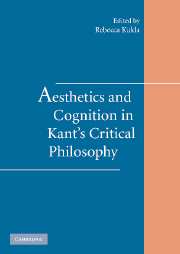Book contents
- Frontmatter
- Contents
- Notes on Contributors
- Acknowledgments
- 1 Introduction: Placing the Aesthetic in Kant's Critical Epistemology
- PART I SENSIBLE PARTICULARS AND DISCURSIVE JUDGMENT
- PART II THE COGNITIVE STRUCTURE OF AESTHETIC JUDGMENT
- PART III CREATIVITY, COMMUNITY, AND REFLECTIVE JUDGMENT
- Bibliography
- Index
1 - Introduction: Placing the Aesthetic in Kant's Critical Epistemology
Published online by Cambridge University Press: 24 July 2009
- Frontmatter
- Contents
- Notes on Contributors
- Acknowledgments
- 1 Introduction: Placing the Aesthetic in Kant's Critical Epistemology
- PART I SENSIBLE PARTICULARS AND DISCURSIVE JUDGMENT
- PART II THE COGNITIVE STRUCTURE OF AESTHETIC JUDGMENT
- PART III CREATIVITY, COMMUNITY, AND REFLECTIVE JUDGMENT
- Bibliography
- Index
Summary
The primary thesis of this book, taken as a whole, is that we cannot properly understand Kant's critical epistemological program or his account of empirical cognition without also understanding his account of aesthetic judgment, imagination, and sensibility (articulated primarily in his Critique of the Power of Judgment but showing up in bits and pieces in the Critique of Pure Reason). And yet, the book also demonstrates that placing the aesthetic within Kant's cognitive theory is a difficult task that often risks challenging that theory from within. Between them, the eleven original essays in this volume show that on the one hand, careful attention to Kant's aesthetics revises and illuminates our entrenched understandings of core elements of Kant's critical epistemology, such as his notions of discursive understanding, experience, and determinative judgment, while on the other hand, a rich grasp of Kant's whole critical project is necessary for making sense of his aesthetic theory.
For most of the twentieth century, Kant's aesthetic theory was marginalized by analytic philosophers, who systematically privileged epistemology and (to a lesser extent) ethics as the core philosophical subdisciplines, and who did not see aesthetics as substantially relevant to these subdisciplines. Kant's third Critique received vastly less scholarly attention than the first two, and the little commentary that it did receive was insulated from the rest of the corpus of Kant scholarship.
- Type
- Chapter
- Information
- Publisher: Cambridge University PressPrint publication year: 2006
- 3
- Cited by

